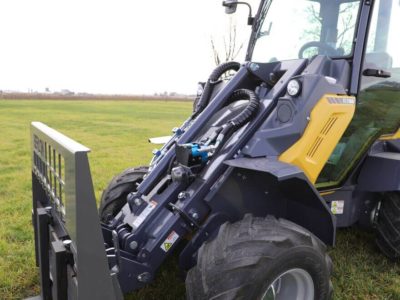Moving parts require lubrication to minimize heat and friction. Pins and bushings depend on this layer of lubrication to help prevent metal-on-metal contact for extended life. Grease helps prevent corrosion and purges debris and contamination from bearing surfaces. Many points on a machine need to be greased daily for preventive maintenance. Skipping grease points or not greasing according to recommended intervals could result in galled pins and bushings and minimized bearing life. Refer to your machine’s operator’s and maintenance manual for safety messages and further instructions.
Even the timing can make a difference. “As a general rule, grease machines after they’re shut down for the day,” Vermeer product specialist Kyle Newendorp explained. “This helps protect the metal under the seals from corrosion as the temperature drops.”
Intervals for greasing equipment are specified in the owner’s manual. But there are situations where you may want to grease the equipment more frequently, such as when working in very wet, muddy, dusty or dirty working conditions.
Don’t miss critical grease points
There are a large number of grease points on many machines and varying locations of certain grease zerks. Be sure to study the diagrams provided in the maintenance manuals.
How often a bearing needs to be greased and the amount of grease it requires varies depending on machine design and application. It’s important to consult your operator’s manual prior to greasing. Establish a routine and grease them in the same order every day to help you not miss any. “Vermeer provides a daily checklist on all our machines,” Newendorp explained. “The diagram shows which parts of the machine need to be greased. It details how many shots of grease are needed or if it needs to be purged, which means until the grease visibly comes out of the bearing.”
Understand the process
The process of greasing the bearings is often oversimplified. Over-greasing is a common problem. You must understand the volume of grease being dispensed as well as how the grease applicator works. Some grease guns may develop up to 15,000 pounds per square inch (1,034.2 bar), which can damage some types of bearings if not used properly. Learn the volume of grease being delivered with every shot of the applicator tool being used. Be cautious to prevent over-packing and/or seal damage. Over greasing some bearing cavities can result in higher temperatures and energy loss as the bearing elements must push the excess grease out of the way during operation.
With many pin and bushing joints, you will apply grease until it just visibly starts to squeeze out. In a well-maintained machine, it should only take a pump or two of grease. This grease also helps to purge contaminants from bearings. Over greasing these types of bearings can attract dirt and debris.
Preventive maintenance includes taking care of your tools to keep contaminants at bay. Avoid laying grease applicators on dirty surfaces and be sure to repack them on a clean bench.
Choose the right product
There are different types of grease for different applications and temperatures. The climate and time of year can make a difference. Make sure you use the proper type of grease as spelled out in the operator’s manual. For instance, on the pivot shafts of Vermeer ATX720 to ATX850 compact articulated loaders (ATXs), a type 0088 Pakelo bearing EP grease NLGI or equivalent is recommended. The EP refers to extreme pressure, and NLGI refers to the National Lubricating Grease Institute. This grease is formulated with additives that maximize its load-carrying capacity and continue to help prevent metal-to-metal contact while the loader arms are subjected to heavy loads. Depending on the application, there are also all-purpose (AP) and multi-purpose (MP) grease variants available.
The viscosity of the grease is another important consideration for preventive maintenance. Viscosity can range from fluid, NLGI #000, to very hard, NLGI #6. NLGI #2 is the most common because it can be used for a wide temperature range. When the temperature plunges, it may be a good idea to use either NLGI #1 or synthetic grease. NLGI #0 is commonly used in auto lube systems where the grease must be fluid enough to circulate through several feet of hose.
It’s also important to make sure a grease is compatible before switching types, viscosities or brands. Not all thickeners used in various grease products are compatible.
Attention to detail matters
Make sure all fittings and the grease applicator nozzle are clean prior to applying the grease. Dirt left on the grease zerk fitting or the tip of the applicator will be injected into the bearing surface, where it can cause premature wear.
Use a clean shop rag or lint-free cloth to clear debris. You may also use grease gun nozzle caps to help keep contamination out of the applicator.
If any fittings are missing or refuse to take grease, replace them immediately. It’s a good idea to always have a supply of spare grease fittings on hand.
Daily greasing is an important preventive maintenance task. A little attention to detail can go a long way toward achieving your fleet management objectives.
Vermeer Corporation reserves the right to make changes in product engineering, design and specifications; add improvements; or discontinue manufacturing or distribution at any time without notice or obligation. Equipment shown is for illustrative purposes only and may display optional accessories or components specific to their global region. Please contact your local Vermeer dealer for more information on machine specifications.
Vermeer and the Vermeer logo are trademarks of Vermeer Manufacturing Company in the U.S. and/or other countries. © 2022 Vermeer Corporation. All Rights Reserved.
